Electricity from a Laser Beam: DARPA POWER Research Program
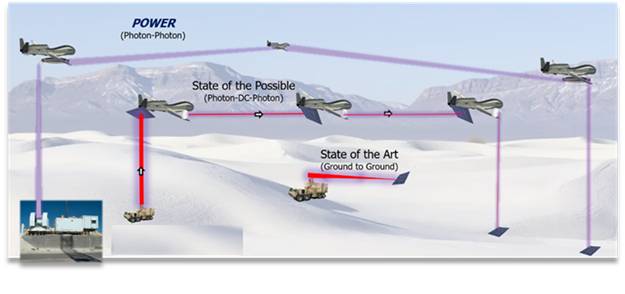
Plans for the POWER program. At the first stage, they will test the transfer of energy between ground facilities, and then they will begin to introduce air components
The US Army, like any other modern military, is critically dependent on the supply of electricity. Depending on the location, units and subdivisions receive electricity from existing infrastructure or from their own mobile power plants. In the latter case, the supply of fuel can be associated with difficulties and risks. In this regard, a search for new principles of energy generation or transmission has been underway for quite a long time. So, the DARPA agency is now conducting the POWER program, during which it is studying the possibility of transmitting energy using a laser beam.
Wireless energy
In early October 2022, DARPA first announced the launch of a new energy research program. The study was called Persistent Optical Wireless Energy Relay, or POWER for short.
By the time of the first open mention of the POWER topic, the Agency's specialists had drawn up a general concept and identified areas for further work. They also adopted a plan that provides for several stages of development.
As the name implies, the goal of the program is to find and develop technologies for power transmission "over the air" using optical means. It is assumed that with the proper level of development, such devices will be able to ensure the transmission of significant powers to the required ranges. With a favorable development of the project, in terms of the combination of technical and operational characteristics, the POWER system should surpass existing methods and means - land-based power lines or diesel generators in conjunction with tank trucks.
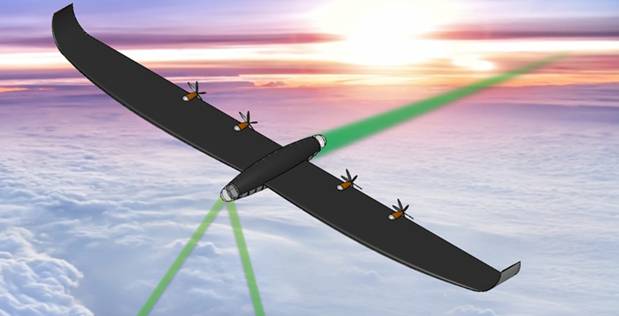
Possible appearance of an unmanned repeater
The research program is divided into several stages. At the first stage, they will show the fundamental possibility of solving the main problem, as well as find the optimal components and means. The next two stages provide for the further development and scaling of these technologies with access to indicators that allow the implementation of the system in operation.
It is known that one of the departments of the DARPA agency is engaged in the POWER program. Whether other organizations and enterprises were involved in it has not yet been specified. In addition, due to the total complexity of the tasks set, the Agency cannot even give an approximate date for the completion of work and the possible start of operation of the finished system.
Technical aspects
The POWER program proposes the development of a power transmission system based on several components. Such a system should include a transmitting and receiving station, as well as, if necessary, intermediate repeaters. Depending on the specific needs of the customer, the system components must have different designs and characteristics.
The transmitting station is proposed to be located near the power source or related infrastructure. The main element of such a station is a laser with sufficient radiation power and the possibility of long-term continuous operation. The station must convert electricity from the grid / from the generator into a laser beam. With the help of appropriate optics, the beam is proposed to be directed towards the receiver.
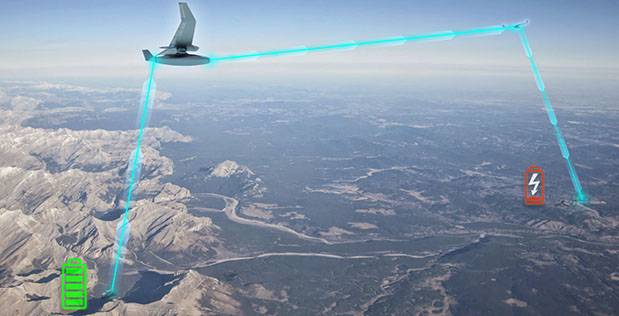
The receiving station, in turn, must capture the laser beam with its solar panels and convert light energy into electrical energy. Further, electricity can be distributed among consumers.
A system of transmitting and receiving stations can only operate within line of sight. To transmit energy over long distances, it is proposed to include intermediate repeaters in the system. It will be some kind of system capable of receiving a laser beam and transmitting it further - due to reflection or conversion through an electrical system.
Thus, when creating a POWER system, DARPA specialists and related organizations will have to solve several engineering problems of varying complexity. For example, the creation of a high-power laser emitter with precise beam guidance is a very real task. A number of similar military systems have been created in the United States, and the experience gained will help in the new project. The receiving station is also quite simple.
The greatest difficulties are expected when creating repeaters, as well as platforms for them. They can be performed on the basis of unmanned aerial vehicles capable of staying in one place for a long time and providing energy transfer. It may be necessary to develop completely new UAVs with the desired characteristics and capabilities.
A separate task is to develop the actual device for redirecting the beam to the next repeater or to the receiving station. For this, in the future, they want to use optical systems with mirrors and lenses capable of directing the beam and additionally focusing it. As a temporary solution, a system with a solar panel and a laser can be used.
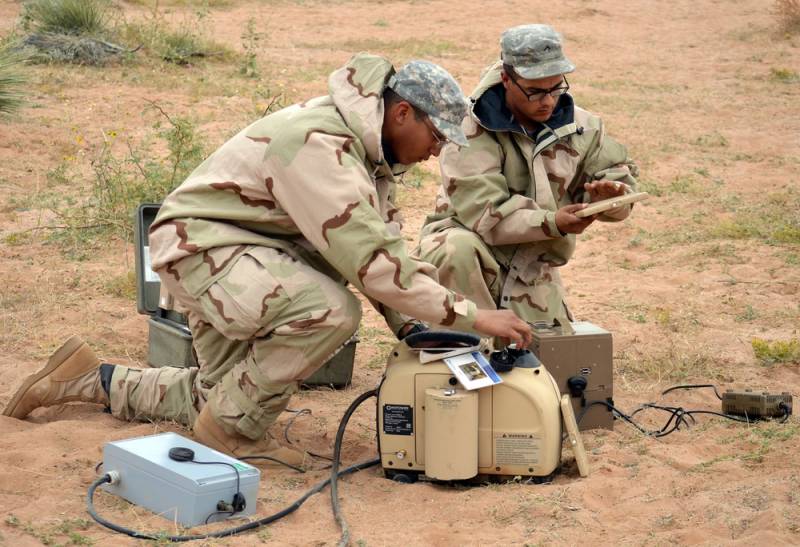
American military personnel start a compact generator
Regardless of the mode of transmission, the system needs accurate guidance on all means, primary and intermediate. If there is a miss at any stage of the transmission, the receiving station will lose the beam and leave consumers without electricity.
Testing and development of the POWER system will be performed in three stages, as new components and devices become available. Thus, the experiments will begin with the transmission of electricity between ground stations at a limited distance. Then new UAVs will be involved in the tests. Probably, at this stage, an intermediate conversion of the beam to electricity and vice versa will be used.
Finally, at the third stage, testing of the complete system will begin. From the transmitting to the receiving station, the laser beam will go through the optical systems on the intermediate UAVs. Of course, if it is possible to create such devices with the required level of performance.
Disadvantages and advantages
DARPA understands that the POWER concept has a number of shortcomings that will make it difficult to develop a full-fledged project, as well as impose restrictions on the operation of the finished system. Nevertheless, it is planned to continue work and, if possible, reduce the impact of negative factors.
First of all, the source of problems is the laser beam itself. As it passes through the atmosphere, it loses power. In addition, atmospheric and weather phenomena can even block it. As a consequence, the reliability and efficiency of such transmission will be low. A laser transmission system, regardless of its composition, cannot be used over long distances.
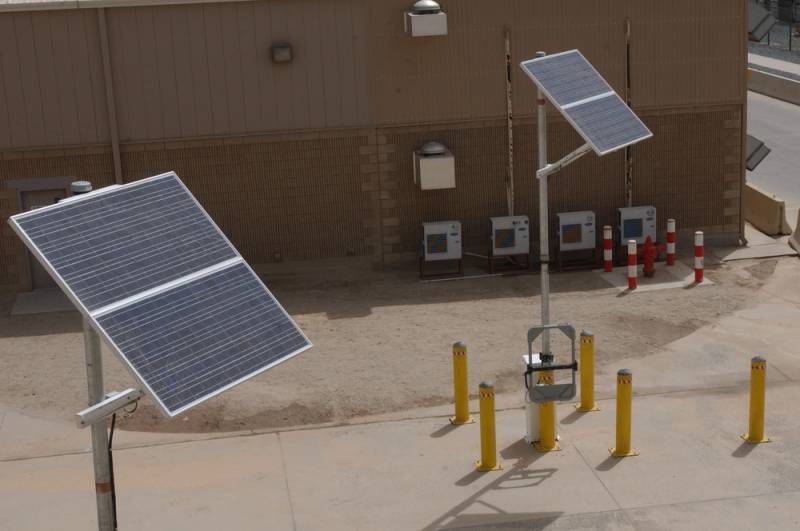
Solar panels at one of the US Army bases
Precise beam guidance systems are important not only for the performance of the system, but also affect its safety. As part of POWER, high-power lasers similar to those used in combat systems should be used. Accordingly, a miss when pointing the beam is a threat. The beam will damage the relay drone or cause damage to ground objects.
Even with the successful resolution of all technical problems and getting rid of the expected problems, the POWER system will be complex and expensive. The cost of energy transmission will also be at an excessively high level, which will not allow it to be massively deployed and used. At a minimum, in terms of total and unit cost, keeping diesel generators and tank trucks would be much more beneficial.
Dubious undertaking
Thus, the DARPA agency began the scientific and practical study of an interesting but dubious concept. The POWER program is of technical interest and will help create important and exciting new technologies. However, the successful completion of the work and the creation of a workable power transmission system is not guaranteed.
It is likely that the POWER program will go through a research and development phase and even go as far as testing individual components. However, its further development is questionable. The expected ratio of technical, economic and operational features of such a system is at an extremely low level. The Pentagon may simply not be interested in the results of the program and not approve further work.
Information